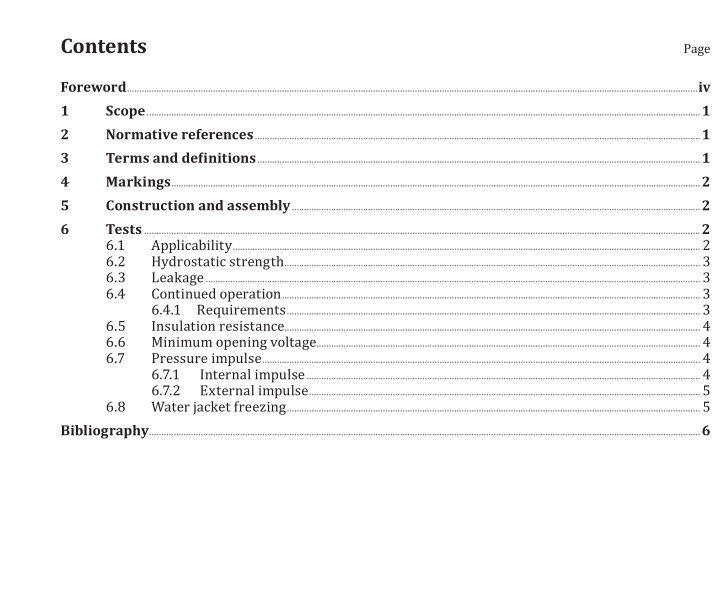ISO 20766-14:2022 pdf download.Road vehicles — Liquefied petroleum gas (LPG) fuel system components — Part 14: Vaporizer/pressure regulator.
This document specifies general requirements for the vaporizer/pressure regulator, a component of liquefied petroleum gas fuel, intended for use on the types of motor vehicles as defined in ISO 3833. It also provides general design principles and specifies requirements for instructions and marking.
This document is applicable to vehicles (mono-fuel, bi-fuel or dual-fuel applications) using gaseous fuels in accordance with ISO 9162. It is not applicable to the following:
a) fuel containers;
b) stationary gas engines;
c) container mounting hardware;
d) electronic fuel management;
e) refuelling receptacles.
It is recognized that miscellaneous components not specifically addressed herein can be examined for compliance with the criteria of any applicable part of the ISO 20766 series, including testing to the appropriate functional tests.
All references to pressure in this document are considered gauge pressures unless otherwise specified.
This document applies to devices which have a service pressure in the range of 110 kPa (butane rich at 20 °C) and 840 kPa (propane at 20 °C), hereinafter referred to in this document. Other service pressures can be accommodated by adjusting the pressure by the appropriate factor (ratio).
2 Normative references
The following documents are referred to in the text in such a way that some or all of their content constitutes requirements of this document. For dated references, only the edition cited applies. For undated references, the latest edition of the referenced document (including any amendments) applies.
ISO 20766-1, Road vehicles — Liquefied petroleum gas (LPG) fuel systems components — Part 1: General requirements and definitions
ISO 20766-2, Road vehicles — Liquefied petroleum gas (LPG) fuel systems components — Part 2: Performance and general test methods
ISO 20766-12, Road vehicles — Liquefied petroleum gas (LPG) fuel systems components — Part 12: Non-return valve
3 Terms and definitions
For the purposes of this document, the terms and definitions given in ISO 20766-1 apply.
6.2 Hydrostatic strength
Test the vaporizer/pressure regulator according to the procedure for testing hydrostatic strength specified in ISO 20766-2. The test pressure shall be 2,25 times the working pressure.
6.3 Leakage
Test the vaporizer/pressure regulator valve at the temperatures and pressures given in Table 2.
6.4 Continued operation
6.4.1 Requirements
The pressure regulator shall be able to withstand 50 000 cycles without any failure when tested according to the following procedure. Where the stages of pressure regulation are separate, the working pressure in a) to f) is considered to be the working pressure of the upstream stage.
a) Recycle the regulator for 95 % of the total number of cycles at room temperature and at the working pressure. Each cycle shall consist of flow until a stable outlet pressure has been obtained, after which the gas flow shall be shut off by a downstream valve within 1 s, until the downstream lock-up pressure has stabilized. Stabilized outlet pressures are defined as set pressure ±15 % for at least 5 s.
The regulator shall comply with 6.3 at room temperature at intervals of 20 %, 40 %, 60 %, 80 % and 100 % of room temperature cycles.
b) Cycle the inlet pressure of the regulator for 1 % of the total number of cycles at room temperature from 100 % to 50 % of the working pressure. The duration of each cycle shall be no less than 10 s.
c) The regulator shall comply with 6.3 at room temperature at the completion of this test.
d) Repeat the cycling procedure of a) at 120 °C at the working pressure for 1 % of the total number of cycles. e) Repeat the cycling procedure of b) at 120 °C at the working pressure for 1 % of the total number of cycles.
The regulator shall comply with 6.3 at 120 °C at the completion of this test. f) Repeat the cycling procedure of a) at −40 °C or −20 °C, as applicable and 50 % of working pressure for 1 % of the total number of cycles. g) Repeat the cycling procedure of b) at −40 °C or −20 °C, as applicable and 50 % of working pressure for 1 % of the total number of cycles.
The regulator shall comply with 6.3 at −40 °C or −20 °C, as applicable at the completion of this test. h) At the completion of the cycles, the lock-up pressure downstream of the regulator shall not exceed the lock-up pressure specified by the manufacturer. 6.5 Insulation resistance The insulation resistance test is designed to check for a potential failure of the insulation between the two-pin coil assembly and the pressure regulator casing. Apply a test voltage of 500 V d.c. for a duration of 60 s between one pin of the coil and the pressure regulator casing; for coil assemblies with circuitry of 3,8 mm pitch or below, 100 V d.c. shall be used. The minimum allowable resistance shall be >10 MΩ.
6.6 Minimum opening voltage The minimum opening voltage at room temperature shall be ≤8 V for a 12 V system and ≤16 V for a 24 V system. The component shall be pressurized at 0,75 times the working pressure during the test. 6.7 Pressure impulse 6.7.1 Internal impulse Conduct the following steps for the internal impulse test.ISO 20766-14 pdf download.ISO 20766-14 pdf download
